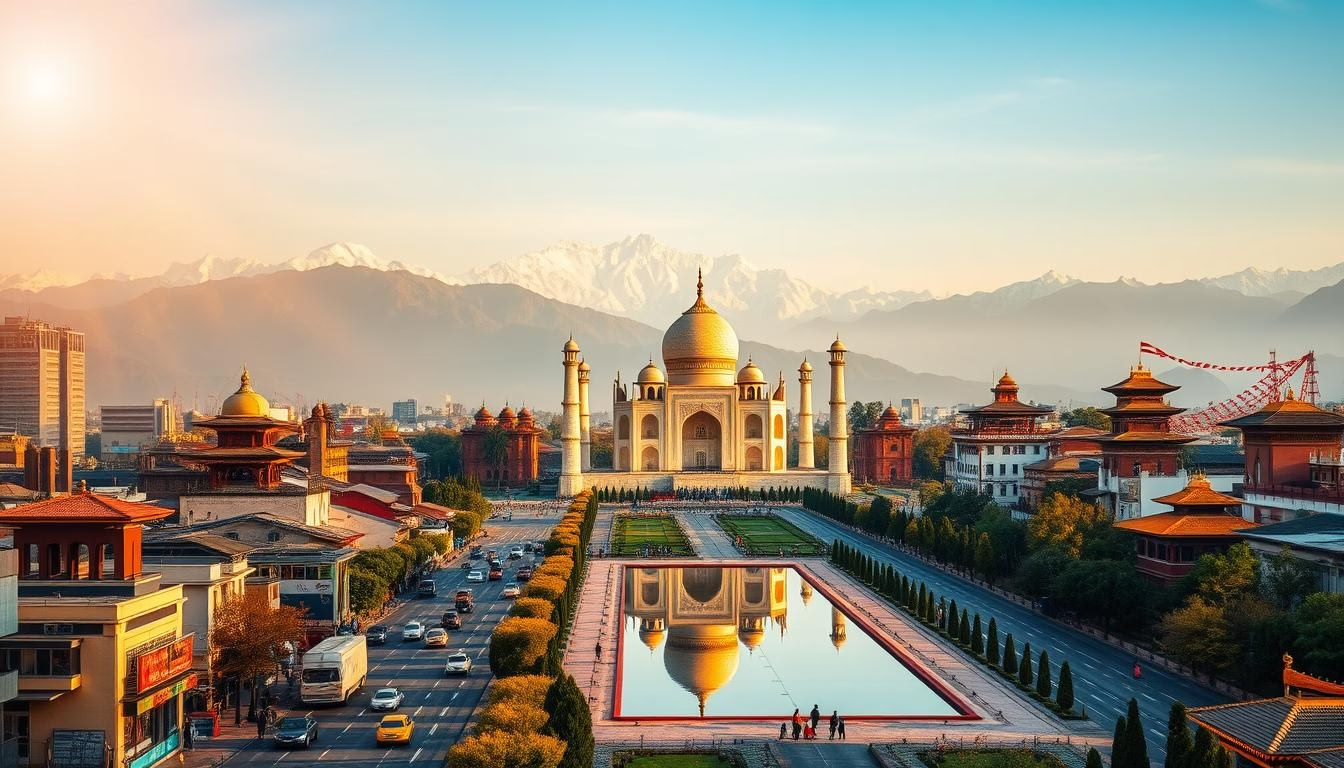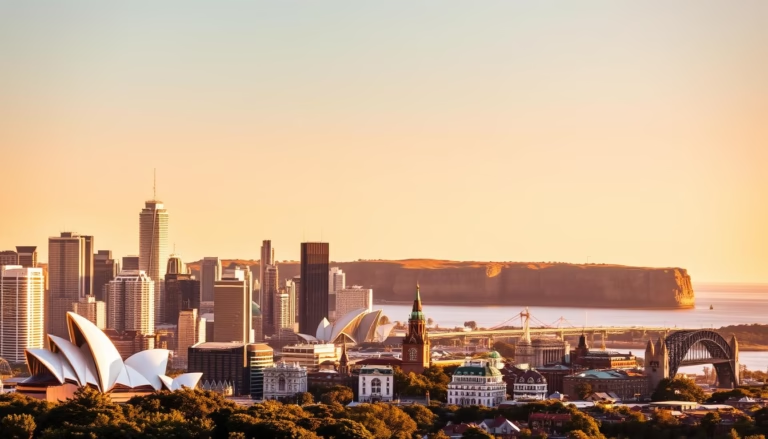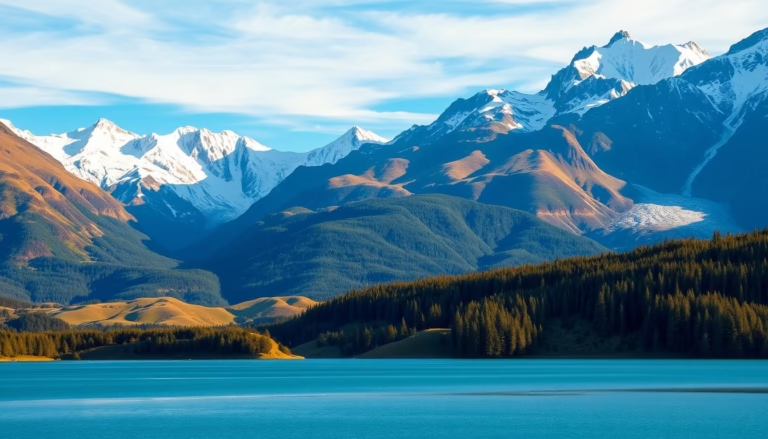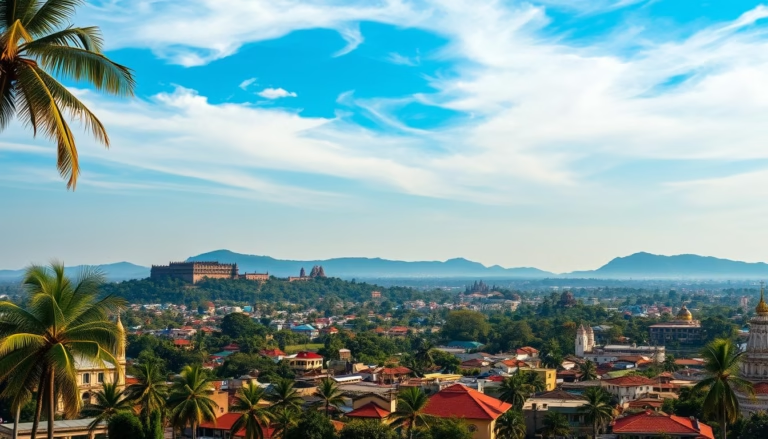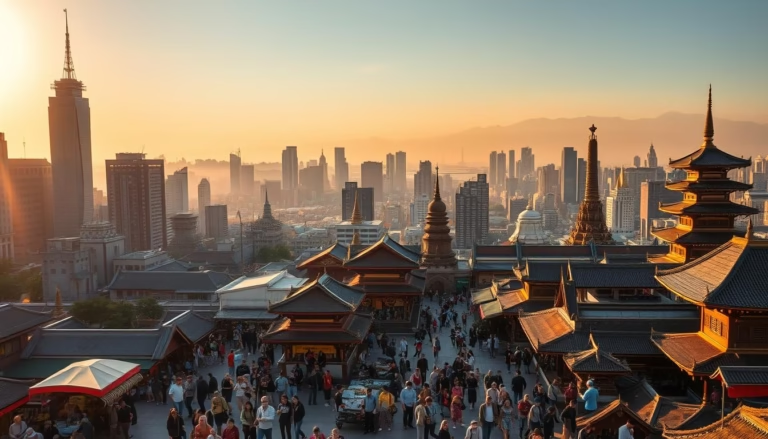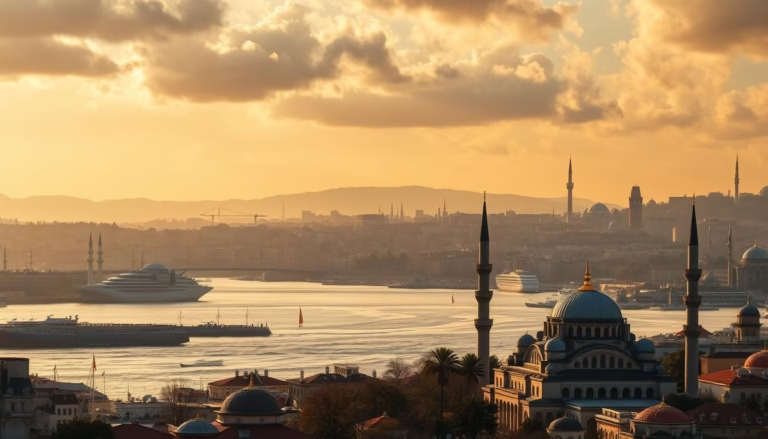Best Countries to Visit in Asia: Top Destinations Uncovered
Did you know Asia accounts for 60% of the world’s most-visited cultural landmarks? From Indonesia’s volcanic landscapes to Japan’s cherry blossom festivals, this continent blends ancient traditions with cutting-edge innovation. Travelers today crave experiences that mix history, nature, and urban energy – and Asia delivers all three effortlessly.
Whether you’re drawn to Thailand’s floating markets or India’s spice-scented bazaars, each destination tells a vivid story. Modern skyscrapers in Singapore contrast with Vietnam’s terraced rice fields, creating endless opportunities for discovery. Even seasoned explorers find new surprises here – like Mongolia’s nomadic festivals or Bhutan’s cliffside monasteries.
Affordable street food stalls sit beside Michelin-starred restaurants, catering to every budget. You could trek Nepal’s Himalayan trails one week and unwind on the Philippines’ powdery beaches the next. This guide reveals how to navigate Asia’s treasures, whether you’re a first-time visitor or a repeat adventurer.
Key Takeaways
- Asia offers unmatched cultural diversity across 48+ nations
- Modern cities coexist with ancient landmarks in most destinations
- Travel options range from $5 street food tours to luxury resort stays
- Seasonal festivals and natural wonders shape ideal visiting times
- Efficient transit systems make multi-country itineraries achievable
Introduction to Asia’s Diverse Destinations
No continent matches Asia’s ability to shift from neon-lit skyscrapers to misty mountain temples between breakfast and lunch. This sprawling region serves up 48+ unique destinations, each with its own rhythm – think Balinese dancers practicing under palm trees while Seoul’s K-pop studios pulse with creativity.
Understanding the Rich Tapestry of Cultures
Local customs shape daily life here more than guidebooks suggest. In one country, you might remove shoes before entering homes; in another, bow instead of shaking hands. Thailand’s floating markets operate like aquatic supermarkets, while Japan’s tea ceremonies turn drink preparation into philosophy.
Three elements define Asian culture:
- Ancient rituals coexisting with robotics labs
- Family-run eateries serving recipes older than some nations
- Festivals celebrating lunar cycles and harvest seasons
Why Asia Should Be on Your Travel Radar
Where else can you experience $1 dumplings and $300/night ryokans in the same city? Manila’s jeepneys blast colorful routes past Spanish colonial churches, while Singapore’s hawker centers dish out Michelin-starred chicken rice. Budget-conscious travelers thrive here, but luxury seekers find equal delight.
Geography plays tricks too – ski Hokkaido’s powder in February, then swim in Philippine turquoise waters by March. This continent doesn’t just welcome visitors; it reshapes how they see the world.
Discover the “best countries to visit in asia” for Unforgettable Adventures
Adventure pulses through Asia’s streets and wilderness alike. Travelers find perfect harmony between skyscrapers and sacred spaces, where neon lights fade into misty mountain trails within hours. Two standout places to visit – South Korea and Japan – exemplify this balance through their mix of heritage and innovation.
Key Attractions and Must-See Sights
South Korea shines with layered experiences. In Gyeongju, 1,000-year-old temples like Bulguksa whisper ancient secrets. Seoul’s Bukchon Hanok Village hosts kimchi workshops beside K-pop dance studios. Don’t miss Busan’s twilight harbor cruises or guided DMZ tours revealing living history.
Japan’s islands deliver contrasting thrills. Hokkaido’s steaming volcanoes attract hikers, while Fukuoka’s yatai stalls serve ramen recipes unchanged for generations. Nagasaki blends Dutch trading post relics with atomic history museums. Kyoto’s geisha districts sit just bullet train rides from Tokyo’s robot-themed restaurants.
| Destination | Cultural Sites | Natural Wonders | Unique Activities |
|---|---|---|---|
| South Korea | Gyeongju temples | Jeju Island lava tubes | DMZ peace tours |
| Japan | Kyoto tea houses | Mount Fuji trails | Tokyo fish market visits |
Both countries in Asia excel at blending old and new. Sleep in Seoul’s hanok guesthouses with heated floors, then dance through Hongdae’s indie music scene. In Japan, ryokan inns offer kaiseki feasts before you board shinkansen trains to alpine onsens. Every journey here becomes a story worth retelling.
Cultural Richness and Historic Sites Across Asia
Ancient stone carvings glow golden at sunrise while moss-covered statues guard forgotten jungle pathways. Asia’s landscape serves as an open-air museum showcasing humanity’s artistic and spiritual journey through millennia.
UNESCO World Heritage Sites and Ancient Temples
Cambodia’s Angkor complex redefines scale in historical exploration. The 402-acre Angkor Wat temple reveals intricate bas-reliefs depicting Hindu epics, while Ta Prohm’s strangler fig roots swallow stone walls whole. Local guides often share, “These sites aren’t ruins – they’re living classrooms where history breathes.”
Myanmar’s Bagan plains astonish with 2,200 red-brick pagodas. Sunrise hot air balloon rides reveal their true majesty. Meanwhile, Java’s Borobudur temple features 2,672 relief panels illustrating Buddhist teachings – a stone encyclopedia older than Europe’s universities.
Experiencing Local Traditions and History
At dawn, saffron-robed monks still collect alms in Luang Prabang, continuing rituals from the 14th century. In Bali, villagers prepare canang sari offerings daily – palm-leaf baskets filled with flowers and rice.
These practices create bridges between eras. As one Balinese artisan noted, “We don’t preserve traditions behind glass. We live them.” Visitors might join Kyoto’s tea ceremonies or learn silk weaving techniques near Vietnam’s My Son Sanctuary.
From shadow puppet theaters to temple blessing rituals, Asia’s culture remains vibrantly accessible. The past here isn’t archived – it’s the foundation for tomorrow’s innovations.
Vibrant Experiences in Southeast Asia: Food, Markets, and Festivals
Southeast Asia’s streets buzz with sizzling woks and laughter as dusk paints the sky. Here, every meal becomes a celebration of heritage, and market stalls double as stages for cultural exchange. The region’s culinary landscape acts as a gateway to understanding its people, history, and rhythms of daily life.
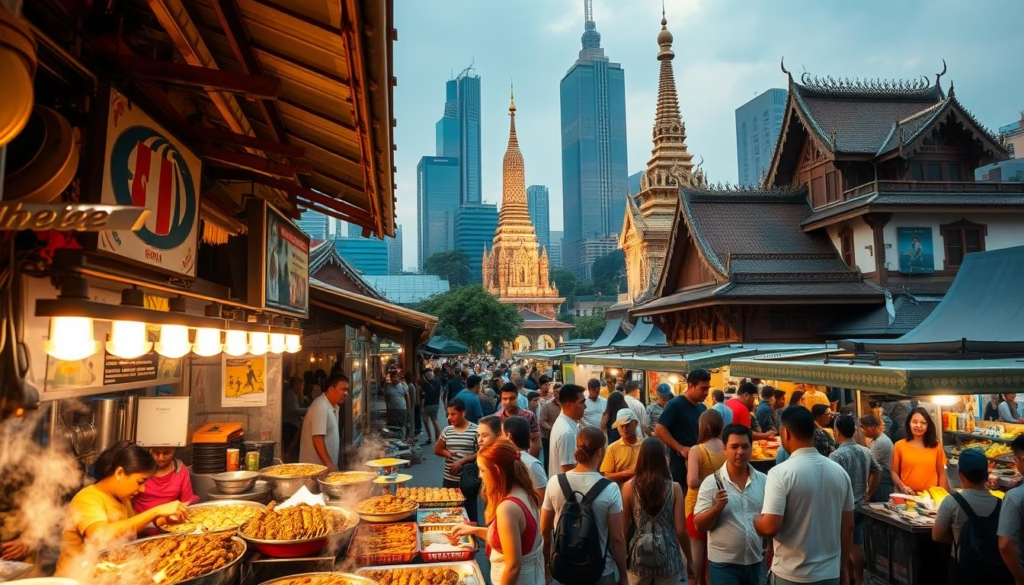
Savoring Local Cuisines and Street Food Scenes
Thailand’s food culture dazzles with contrasts – fiery som tam salads meet coconut-rich curries in perfect harmony. Bangkok’s Yaowarat Road comes alive at night, where $1 skewers share sidewalks with Michelin-recognized street food stalls. As one vendor explains, “Our recipes travel from grandmother’s kitchen to your paper plate – no fancy restaurants needed.”
Exploring Bustling Markets and Lively Festivals
Chiang Mai’s Saturday Night Market transforms into a sensory playground:
- Artisans demonstrate century-old silk-weaving techniques
- Grilled sai oua sausages perfume the air with lemongrass
- Local families shop for weekly supplies beside curious travelers
George Town’s morning markets reveal Malaysia’s cultural fusion – Chinese dumpling stalls neighbor Indian spice merchants. These hubs do more than feed bodies; they nourish communities. During festivals like Vietnam’s Mid-Autumn celebrations, mooncake vendors become keepers of ancestral stories.
Exploring Iconic Destinations: Japan, South Korea, and Indonesia
Three nations redefine how urban energy and cultural heritage coexist. Japan, South Korea, and Indonesia each craft distinct identities where neon-lit skylines frame ancient shrines, and family-run traditions thrive alongside futuristic innovations.
Modern Cities with a Rich Cultural Background
Fukuoka’s yatai stalls glow like fireflies under night skies, serving ramen recipes older than the New York Times itself. This city preserves outdoor dining traditions lost elsewhere, earning global recognition in 2023 travel lists. Meanwhile, Seoul’s Bukchon Hanok Village offers hanbok-clad travelers Instagram moments against 600-year-old architecture.
| Destination | Modern Highlights | Cultural Treasures | Local Experiences |
|---|---|---|---|
| Japan | Tokyo’s robot cafes | Fukuoka yatai stalls | Nagasaki weekend escapes |
| South Korea | Seoul’s Dongdaemun Design Plaza | Andong mask dance festivals | Busan seafood markets |
| Indonesia | Jakarta skyscrapers | Borobudur sunrise viewings | Bali rice terrace walks |
Off-the-Beaten-Path Attractions and Local Experiences
Hokkaido’s Shikotsu Lake mirrors volcanic peaks so perfectly, you’ll question reality. Locals whisper, “This wilderness feels closer to Alaska than Tokyo.” Indonesia’s Bromo region delivers dawn jeep tours across Martian-like landscapes – guided adventures most travelers couldn’t organize solo.
Java’s Prambanan Temple complex stuns with Hindu spires piercing clouds. For authentic experiences, Bali’s Penglipuran Village teaches coconut-leaf weaving between waterfall swims. These islands prove Asia’s magic lies beyond postcard hotspots.
Hidden Gems: Lesser-Known Countries in Asia
Beyond Asia’s well-trodden paths lie treasures where time moves differently. These destinations reward travelers with unfiltered cultural exchanges and landscapes untouched by mass tourism.
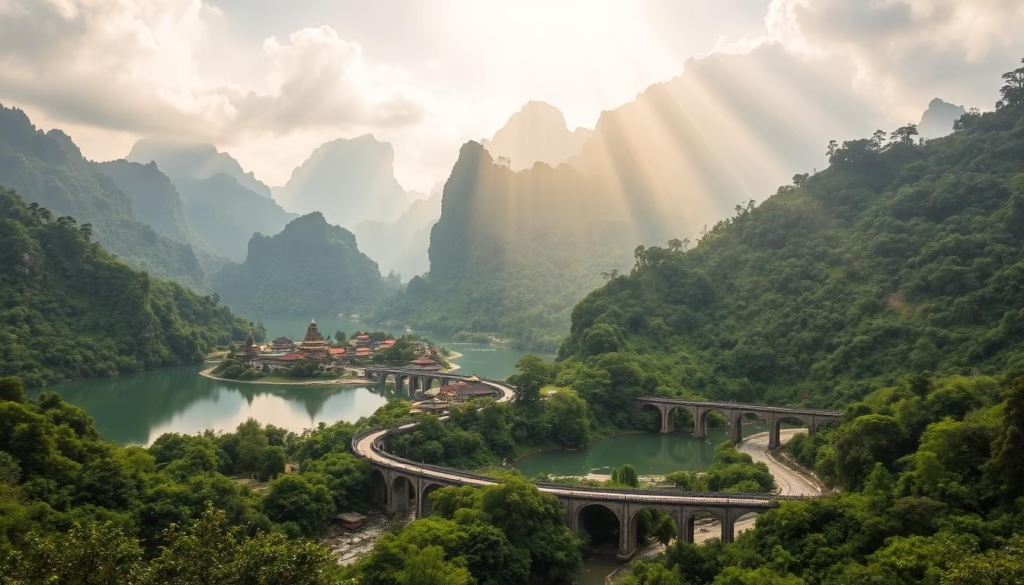
Laos – Off-the-Beaten-Path Cultural Encounters
Luang Prabang reveals Southeast Asia’s soul through morning alms ceremonies and French colonial architecture. A local guide shared, “Our city isn’t frozen in time – it’s learning to dance with modernity while keeping traditions alive.”
The Laos Buffalo Dairy near Luang Namtha turns sustainable tourism into hands-on experiences. Visitors milk water buffaloes while supporting rural communities. This place showcases how ethical travel can fuel economic growth.
Mongolia – Festivals and Vast Natural Landscapes
July’s Naadam Festival transforms the steppe into a living museum of nomadic heritage. Athletes compete in wrestling matches lasting hours, while archers hit targets from 75 meters away. Summer weather patterns create ideal conditions for horseback adventures across endless grasslands.
| Feature | Laos | Mongolia |
|---|---|---|
| Best Experience | Riverine village homestays | Ger camp stays under stars |
| Cultural Highlight | Phonsavan’s ancient stone jars | Eagle hunting traditions |
| Ideal Season | Nov-Feb (cool & dry) | Jun-Aug (festival season) |
These lesser-known countries offer what crowded hotspots can’t – space to breathe and connect. Whether learning silk weaving techniques or racing across dunes, they prove Asia’s magic lives beyond guidebook pages. The ideal season to visit Asia’s hidden corners? Whenever you’re ready to trade convenience for wonder.
Beaches, Islands, and Coastal Escapes Across Asia
Hidden among Asia’s diverse landscapes are coastal gems where time slows to the rhythm of waves. While cities buzz with energy, these shores invite barefoot strolls and sunset cocktails. You’ll find both lively resort hubs and untouched stretches of sand within easy reach.
Relaxing Resorts and Secluded Beach Towns
Thailand’s Ko Samui Island blends convenience with natural beauty. Resort-style properties line its coasts, offering spa treatments with ocean views. Neighboring Koh Lanta delivers quieter charms – think white sand beaches framed by limestone cliffs.
Indonesia’s Gili Air proves small islands pack big surprises. Walk its perimeter in 20 minutes past beach clubs serving fresh-caught tuna. Nearby Nusa Penida and Nusa Lembongan near Bali dazzle travelers with dramatic shorelines minus the crowds.
These coastal escapes redefine relaxation. Whether you crave yoga retreats or snorkeling adventures, Asia’s beaches and islands deliver paradise on your terms. Pack light – the only decision you’ll need is which beach to explore first.
